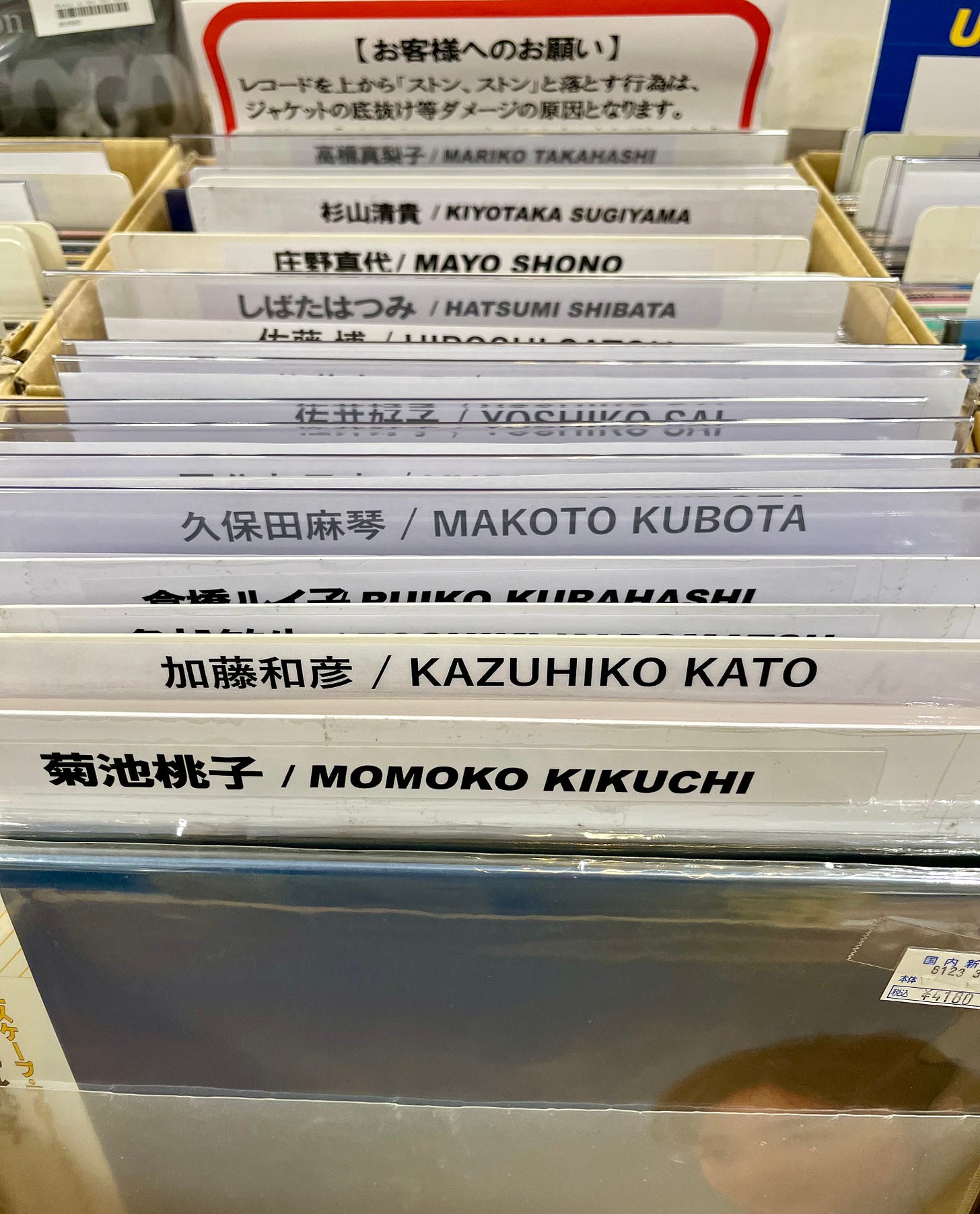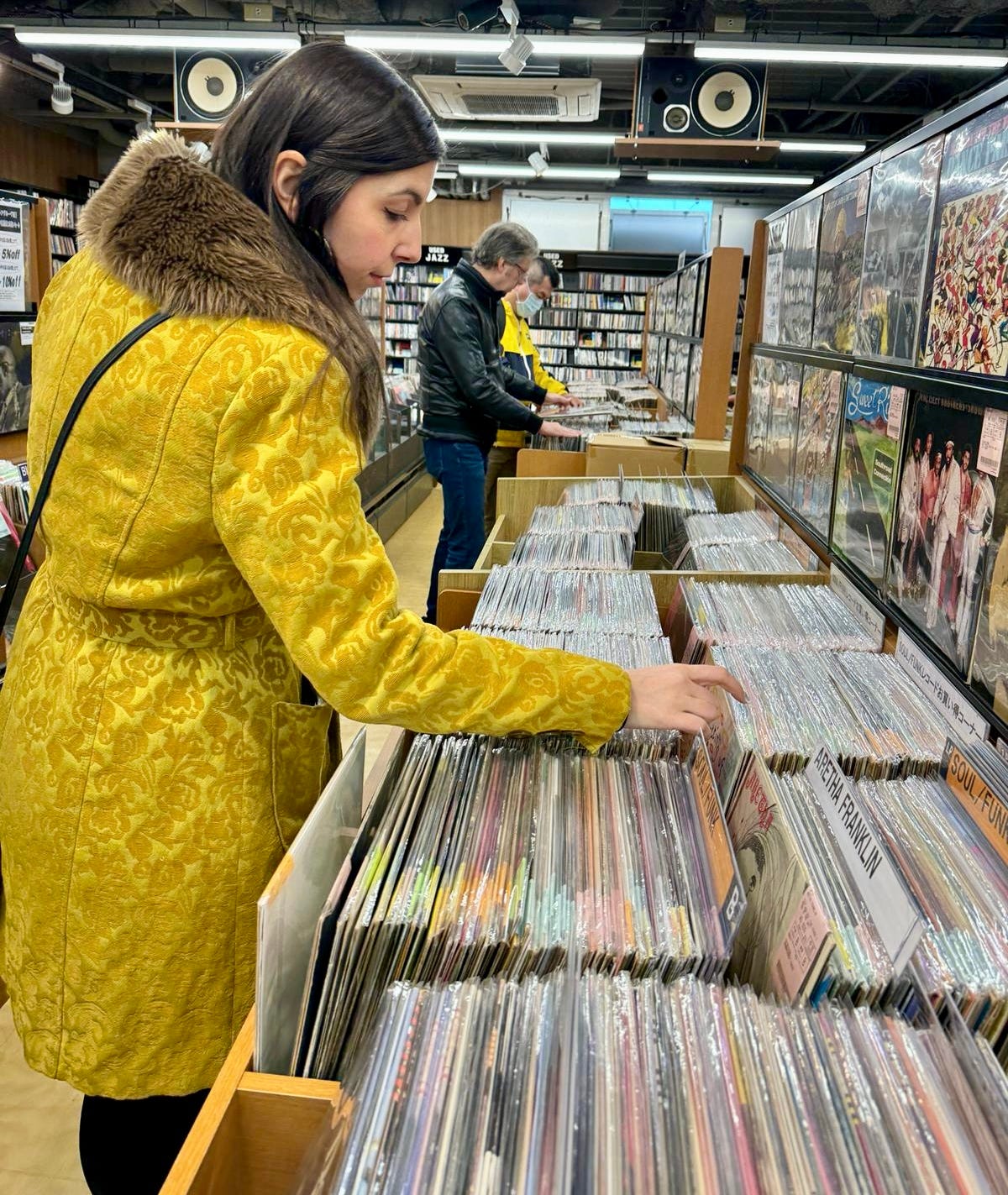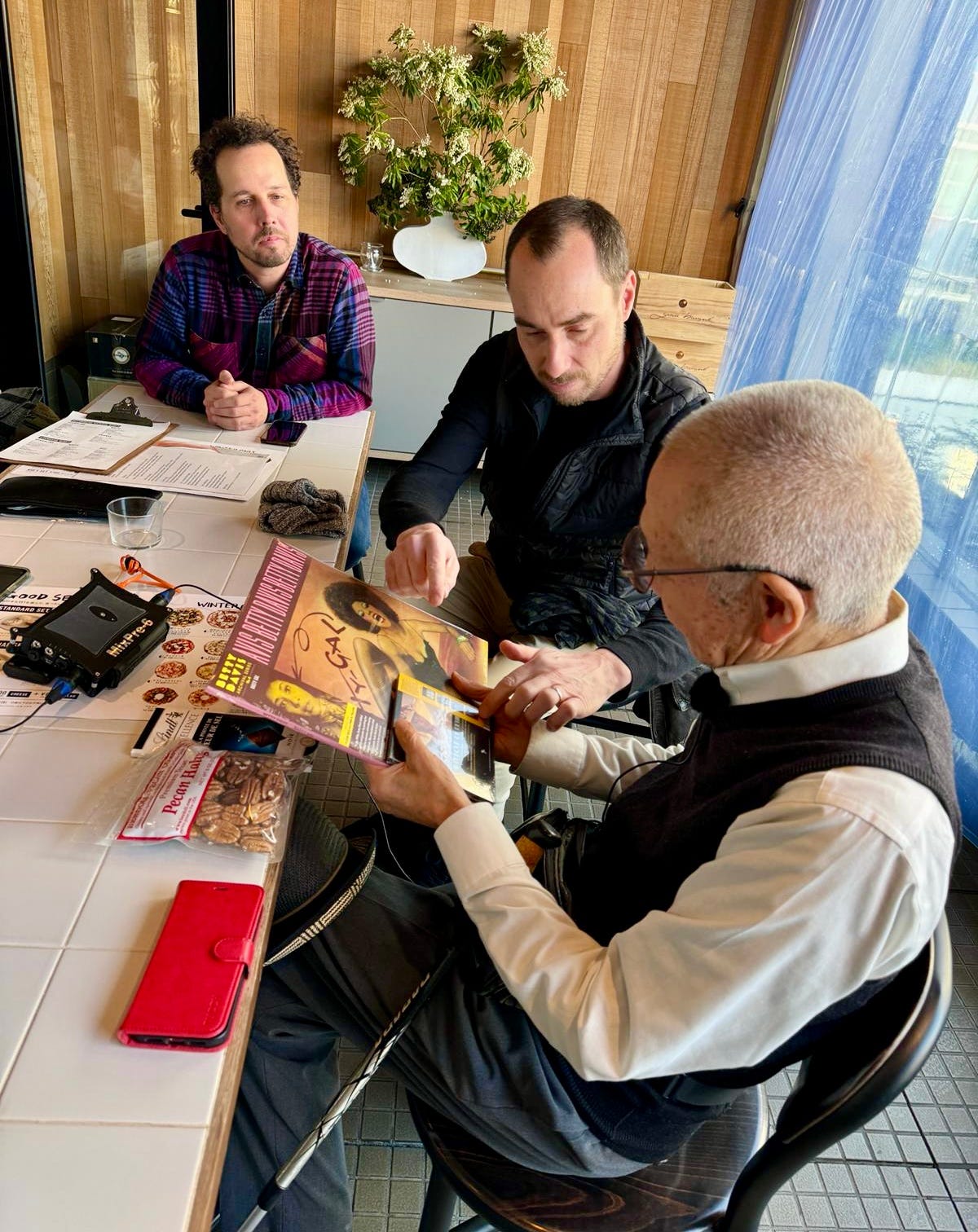Day 2: Sunday, March 3rd, 2024
I awoke to my first morning in Japan feeling oddly rested after a late night of Izakaya libations. The inevitable grogginess from the thirteen-hour time difference was counterbalanced by my extreme excitement for the day ahead. Aside from our upcoming pilgrimage to Mt. Fuji, today was the most crucial day of the trip because today we were meeting two key figures in Betty Davis’s Japan story: Mr. Tatsuhiko Arakawa (Arakawa-San) and Mr. Itsuro Shimoda (Shimoda-San).
But before those two meetings could take place, two other crucial items of business needed to happen: breakfast and record digging. I made my way down to All Day Place’s restaurant and met up with Damon, John, Matt, and Greg. After several cups of coffee and a salmon toast that I’m still craving, we planned our record store route. All of us in the group fancy ourselves serious collectors, but Matt and Greg, each co-owners of record labels (Light in the Attic and 180g respectively), were the only two that had ever been to Japan before and knew the extent of seriousness that was Japanese record stores.
Our first stop was a must-see attraction, the nine-floor Tower Records in the heart of Shibuya. From an American point of view, visiting Tower Records was an exceptionally nostalgic experience given that the American stores closed in 2006. The cultural significance of Japan’s flagship store became more and more clear as we took the elevators up each level. Droves of people eager to buy physical albums crowded the vast, polished space, embodying the giant slogan under the Tower Records sign which read: NO MUSIC, NO LIFE.
Next up was RECOfan. Established in 1981, the vinyl retailer recently reopened its doors after being closed for a brief period in 2020 due to the Covid pandemic. I immediately went to the section of City Pop ruled by Japanese women vocalists such as Momoko Kikuchi, Miki Matsubara, Junko Ohashi, and Tomoko Aran. I selected Junko Yagami’s 1983 album I Wanna Make A Hit Wit-Choo and then turned my attention toward Japanese prints of some of my favorite American women vocalists, such as Candi Staton, Bettye LaVette, Gladys Knight, Sarah Vaughan, and Tina Turner.
We then headed to our final daytime digging site: Disk Union. Established in 1967, this network of vinyl shops, consisting of hundreds of thousands of records that are conveniently filed by genre on each individual floor, blew my mind. The first two floors are omnivorous in their approach, but head up the stairs and you’ll be in dance/club and hip-hop heaven. The next level up delivers an unmatched punk, hardcore, and heavy metal analog fantasy. Keep going and you’ll find the sort of rare groove, soul, and jazz that Discogs wantlists are made of. As the elevator door opened to the top level, Matt whispered: “Welcome to paradise.”
Spellbound by Disk Union’s multiverse, we realized we were due back to meet with Arakawa-San in a matter of minutes. With heavier bags and lighter wallets, we rushed back to our hotel to meet the man who led the last band to ever back Betty Davis.
…
Meeting with Arakawa-San had been in the works for several years, ever since 2019 when Saori Kappus (neé Asaba), a Japanese woman who was a backing vocalist for the band in the early 80s, contacted me to reconnect with Betty. Saori, who had moved to the US in 1986, traveled back to Japan for an Arakawa reunion in August of 2019 and returned with a cassette tape containing a partial live audio of one of Betty’s performances at The Crocodile Club.
We arrived back at the hotel exactly as Arakawa-San got out of his taxi and greeted the 80-year-old saxophone player. Originally starting out in straight jazz, he was quickly inspired to incorporate blues and funk into his sound after a brief stay in the US in the late 1960s. Arakawa-San formed his jazz-funk fusion band in 1980, and the group put out their masterful debut album, Lena, that same year.
As is custom when having a formal meeting with someone in Japan regarding matters of business, Matt presented Arakawa-San with gifts of Betty’s records and Berdoll Pecans from Cedar Creek, Texas. Arakawa-San brought his own gifts, as well. To our absolute astonishment, he presented us with copies of his handwritten musical transcriptions for some of Betty’s songs that they performed, including “Steppin’ In Her I. Miller Shoes,” “Getting Kicked Off, Havin Fun,” and “The Lone Ranger.”
I showed him pictures of the Arakawa Band from the early 1980s that Saori had shared with me. We watched his face light up with a nostalgic glow, gently nodding in approval and confirming the names of band members and other personnel as he pointed to his old friends, many of whom were now deceased.
One of the photos showed the band celebrating as a group on the stage with an unidentified Black woman. When I asked Arakawa-San who this was, he proceeded to tell us that the woman in the picture was named Shoody, and she was, in fact, the daughter of the first President of Mozambique, Samora Machel (who ruled from the country’s independence in 1975 until his death in 1986). Shoody was an aspiring singer and gigged with the Arakawa Band a few times. After a brief stint in Tokyo, she moved to New York City. Arakawa was left in need of a vocalist when Mr. Nishi at The Crocodile Club recommended a new singer he was just introduced to by Alex Easley, an American musician living in Tokyo. This connection led Arakawa to their new lead singer: Betty Davis.
Arakawa-San proceeded to tell us how he rented a rehearsal studio and began learning Betty’s original material. What made him decide to perform her material, I asked? While he was very familiar with her ex-husband, Miles Davis, he was not familiar with Betty’s music and had never heard her perform.
“She was very direct,” he explained. “She taught the band her songs and we followed her feeling.”
They followed that feeling right into a proper, hard rocking groove, freshly punctuated by a bright, jazzy horn section that rocked the audience at The Crocodile Club. From the audio recording, you can hear Betty’s signature growls and hisses commanding the band and dominating the venue. Song after song, the audience hoots and hollers for Betty, affirming her artistry and surrendering their inhibition to her. This was what Betty always longed for from her American audiences: collective liberation through her music where everyone could bag the racial and sexual politics and release their insecurities, even if only for a moment.
No other song from her Japanese recording demonstrates this better than her version of the 1975 song, “Lone Ranger,” which Arakawa-San told us was his favorite song to perform. Betty takes her time with this one, stretching out every second of the slow burning anthem of pleasure through deeply erotic moans, groans, and sighs. Teasing and taunting them along the way, she waits for the audience to be fully aroused before performing her dramatic climax. Eat your heart out, Donna Summer!
When asked how Betty compared to Shoody as a singer, Arakawa-San responded: “Betty was more powerful.” We all giggled, knowing full well the extent of that power. Really, at the visceral level, who was ever more powerful than Betty Davis?
…
While the meeting with Arakawa-San had been in the planning stages for years, the meeting with Shimoda-San could not have been more fortuitous. Betty often told us about another “great love” in her life, a musician that she met in Japan while he was playing in a cafe, a guitarist with beautiful, long hair down to his waist.
Beginning his recording career in 1973, Itsuro Shimoda’s sound was a mix of psychedelic folk-pop and traditional Japanese styles. I set out to see if Shimoda-San was still alive and if he would like to possibly meet with us in Tokyo.
To my absolute disbelief, not only was Shimoda-San alive but he was performing in Tokyo on one of the nights we would be in town! The pseudo-assistant-character I made contact with assured me this timing couldn’t be better because Shimoda-San rarely performed anymore (only a handful of times a year) and lived across the country in Kobe where he doesn't own a cell phone or have an email address. He and Betty sounded like two peas in a pod, I thought.
Without any time to spare, we left our meeting with Arakawa-San and headed to La Caña in Shimokitazawa, an intimate basement venue that held 50 people at the most. We grabbed beers from the tiny makeshift bar in the back of the room and wiggled ourselves into the tightly packed audience. An elderly man holding an acoustic guitar emerged from behind the wall of the small, elevated stage. His hair was just long enough to pull back in a ponytail. Joining him was upright bassist, Tomomi Higashi. The duo engaged in a mellow back and forth with Shimoda-San lending his delicate voice to his original songs that spanned his career. He was delivering a serious Leonard Cohen vibe but with more humor and wit. Even at 76 years old, I could understand why Betty was drawn to him.
As Shimoda-San finished his set and made his way back to the bar to light a cigarette and open a fresh bottle of shōchū, we made our move. To our relief, he was expecting us. As the owner cleared the folding chairs and the remaining audience members exited, we set up a large table in the middle of the room for us to gather around, drink, and reminisce about his time with Betty.
Back in 2014, when she began discussing her funeral rite wishes with John, Betty told him that he should “go to Japan one day and meet Shimoda.” The gravity of this moment was not lost on us. Shimoda-San told us that, when they were young together, Betty often told him: “he was the earth, and she was the sun.” My mind immediately remembered a note I came across when organizing Betty’s belongings after she passed. Having personally scanned and archived all her materials, those words sounded so familiar to me. When I arrived back to the States after our trip, I went through my digital archive, and there I found a handwritten note to Betty from Shimoda-San:
Dear Betty,
Do you remember you said you are the sun
I am the earth
I hide myself with my clouds.
How about your Universe?
We’ll sing together
on the earth.
From Dream to reality
that is our story
Itsuro Shimoda
After talking with Shimoda about his memories of Betty and sharing our plans to honor her at Mt. Fuji, we left La Caña and headed back onto the streets of Shimokitazawa. We were all dizzy from the shōchū and the surreal triumph of sitting next to the man who was Betty’s “great love,” the man she told us we should find “one day” in Japan.
All that was left to do – all that we could do – was eat and find a vinyl listening bar where we could marinate on the day’s events. We found a little restaurant called Nishinba and gorged over an exquisite sashimi platter. Slightly less dizzy, we stumbled across Little Soul Café, a vinyl listening bar that specialized in classic soul and R&B. The incredibly narrow space had only enough room for a bar that seated ten and a few small pieces of furniture. Shelves of records created the back wall of the bar and continued to cover every inch of wall space the eye could see. I sat down with a whiskey and realized this was my version of an afterlife.
We could have stayed all night, but we peeled ourselves away and headed back to our hotel. We had an early train to catch for Mt. Fuji in the morning.
















What a joyful and incredible journey. Can’t wait to listen to Shimuda-san.